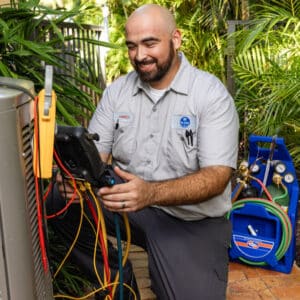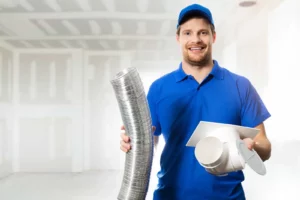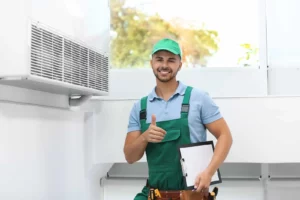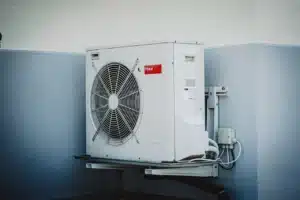How Regular AC Maintenance Can Save You Money
Maintaining your air conditioner regularly is more than just a...
When a Florida summer hits, you expect your central air conditioner to keep your home at a comfortable temperature. If the system is running but the air feels warm, it can be frustrating and uncomfortable. The good news is that not every cooling issue requires a major repair. In many cases, a few basic troubleshooting steps can help you identify the cause of the problem before calling an HVAC technician.
Below are common reasons your central air conditioner may not be cooling properly and what you can do to address them.
Before you start inspecting the system itself, make sure your thermostat is set correctly. Confirm that it is on “cool” mode and that the temperature is set lower than your current indoor reading. If the thermostat is programmable, ensure the schedule is not overriding your cooling settings.
Dead batteries in a thermostat can also cause problems. If your display is dim, flickering, or not responding, replace the batteries and see if the system starts cooling.
One of the most common reasons for weak or warm airflow is a clogged air filter. In Florida, where air conditioners often run for most of the year, filters can fill with dust, pollen, and pet hair quickly. A dirty filter restricts airflow, making it harder for your system to circulate cool air.
Check your filter every month and replace it if it looks dirty. Most homeowners benefit from changing filters every 30 to 60 days, especially during peak cooling season. A clean filter not only improves airflow but also helps prevent damage to your system.
Your central air conditioning system has an outdoor condenser unit that releases heat from your home. If the area around this unit is blocked by debris, plants, or other objects, it can’t work efficiently.
Inspect the unit and remove any leaves, grass clippings, or dirt. Trim back any plants or shrubs to give the unit at least two feet of clearance on all sides. If the condenser fins are visibly clogged with dirt, you can gently rinse them with a garden hose, being careful not to bend the delicate metal.
If your system is blowing warm air, it may have a frozen evaporator coil. This coil is located in the indoor unit and can freeze if airflow is restricted or refrigerant levels are low. When this happens, the system cannot absorb heat from your home effectively.
To check for this, look for visible ice or frost on the indoor unit or on refrigerant lines. If you see ice, turn off the system and allow it to thaw completely before restarting. If the coil freezes again soon after, it may be a sign of a more serious issue that needs professional attention.
If your air conditioner is not cooling at all, the outdoor unit may have lost power. Go to your electrical panel and look for a tripped breaker. If the breaker controlling the condenser has flipped, reset it.
Be aware that a breaker that trips repeatedly may be a sign of an electrical problem within the unit. In that case, call an HVAC technician to avoid damaging the system or creating a safety hazard.
Refrigerant is the substance that absorbs heat from your home and releases it outside. If your system is low on refrigerant, it will struggle to cool effectively. This is often caused by a leak in the refrigerant lines.
Low refrigerant levels are not something you can fix yourself. An HVAC professional will need to locate the leak, repair it, and recharge the system to the proper level. Continuing to run your air conditioner with low refrigerant can cause further damage, including compressor failure.
In some cases, the issue may not be with the air conditioner itself but with the duct system. If ducts are blocked, crushed, or leaking air into unconditioned spaces like the attic, less cool air will reach your living areas.
Signs of duct issues include uneven cooling between rooms, low airflow from vents, and whistling sounds when the system is running. A duct inspection from an HVAC technician can help locate and fix leaks or obstructions.
Strange sounds like grinding, squealing, or banging may indicate mechanical issues inside the air handler or condenser. Musty odors could mean mold is growing in the system or ductwork, while burning smells may point to electrical problems.
If you notice these signs along with poor cooling performance, it is best to shut off the system and contact a technician immediately.
Central air conditioners typically last 10 to 15 years with regular maintenance. If your unit is older and frequently needs repairs, its declining performance may be due to normal wear and tear.
An older system that struggles to cool your home may no longer be worth repairing, especially if it uses outdated refrigerants like R-22. In these cases, replacing the system with a newer, more efficient model can save you money in the long run.
While some troubleshooting steps are simple enough for homeowners to handle, others require professional expertise. You should call an HVAC technician if:
Professional service is also recommended for annual maintenance, which can help prevent cooling issues before they start.
The best way to avoid the frustration of a warm home in the middle of summer is to keep up with preventive maintenance. Here are a few habits to maintain:
By taking these steps, you can extend the life of your air conditioner and maintain consistent cooling performance.
When your central air conditioner is running but not cooling, the cause can range from a simple thermostat setting to a more serious mechanical issue. By checking the basics first, you can often narrow down the problem and decide whether you can fix it yourself or need professional help.
In Florida’s hot climate, a reliable cooling system is not a luxury—it’s a necessity. Addressing small problems early can keep your home comfortable and prevent costly repairs down the road.

Maintaining your air conditioner regularly is more than just a...

Florida homeowners rely on air conditioning more than most parts...

Indoor air quality is a major concern for many Florida...

Indoor air quality, often abbreviated as IAQ, plays a crucial...

Installing a new HVAC system is a significant investment in...

For many homeowners in Florida, the HVAC system is the...